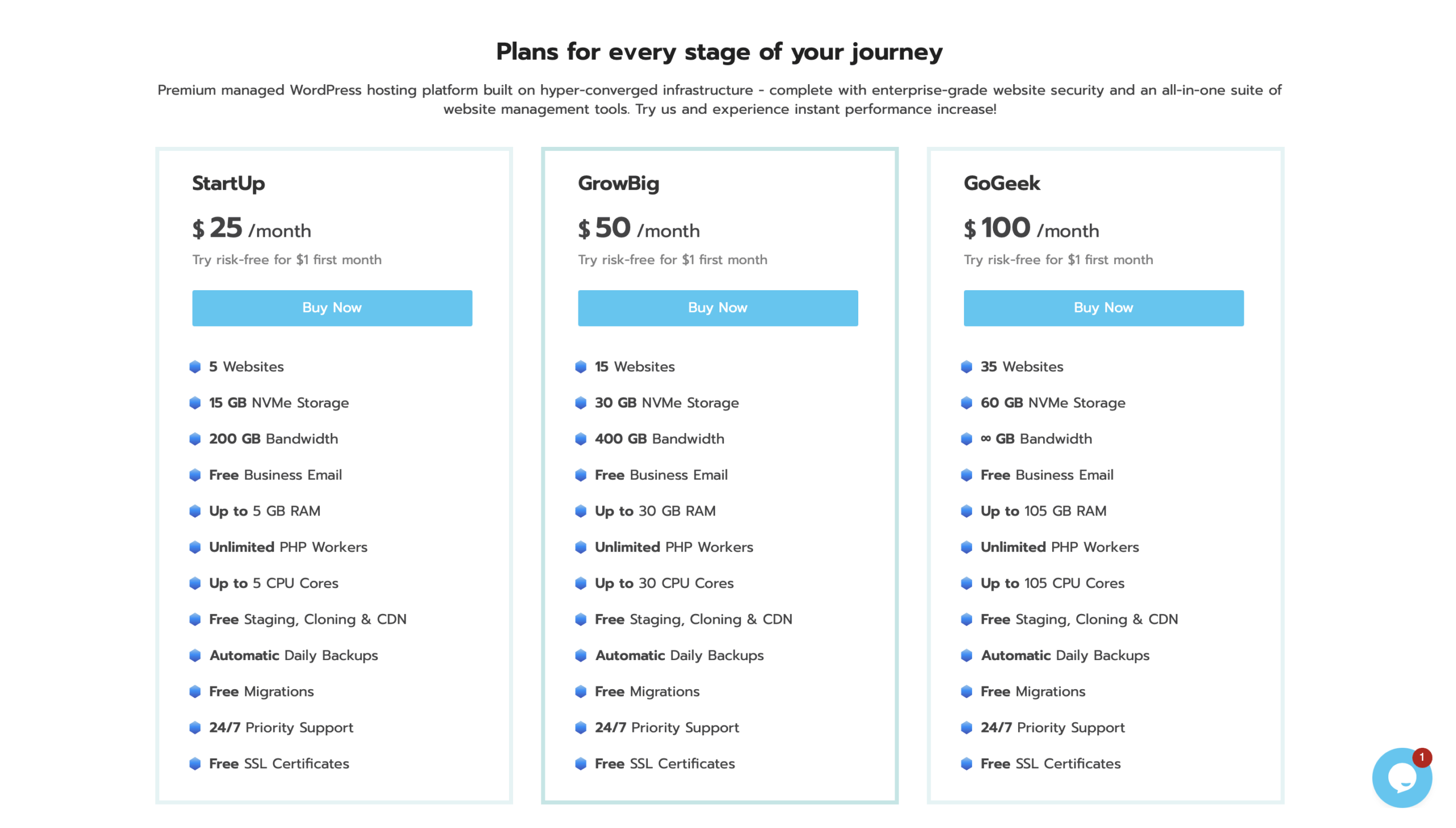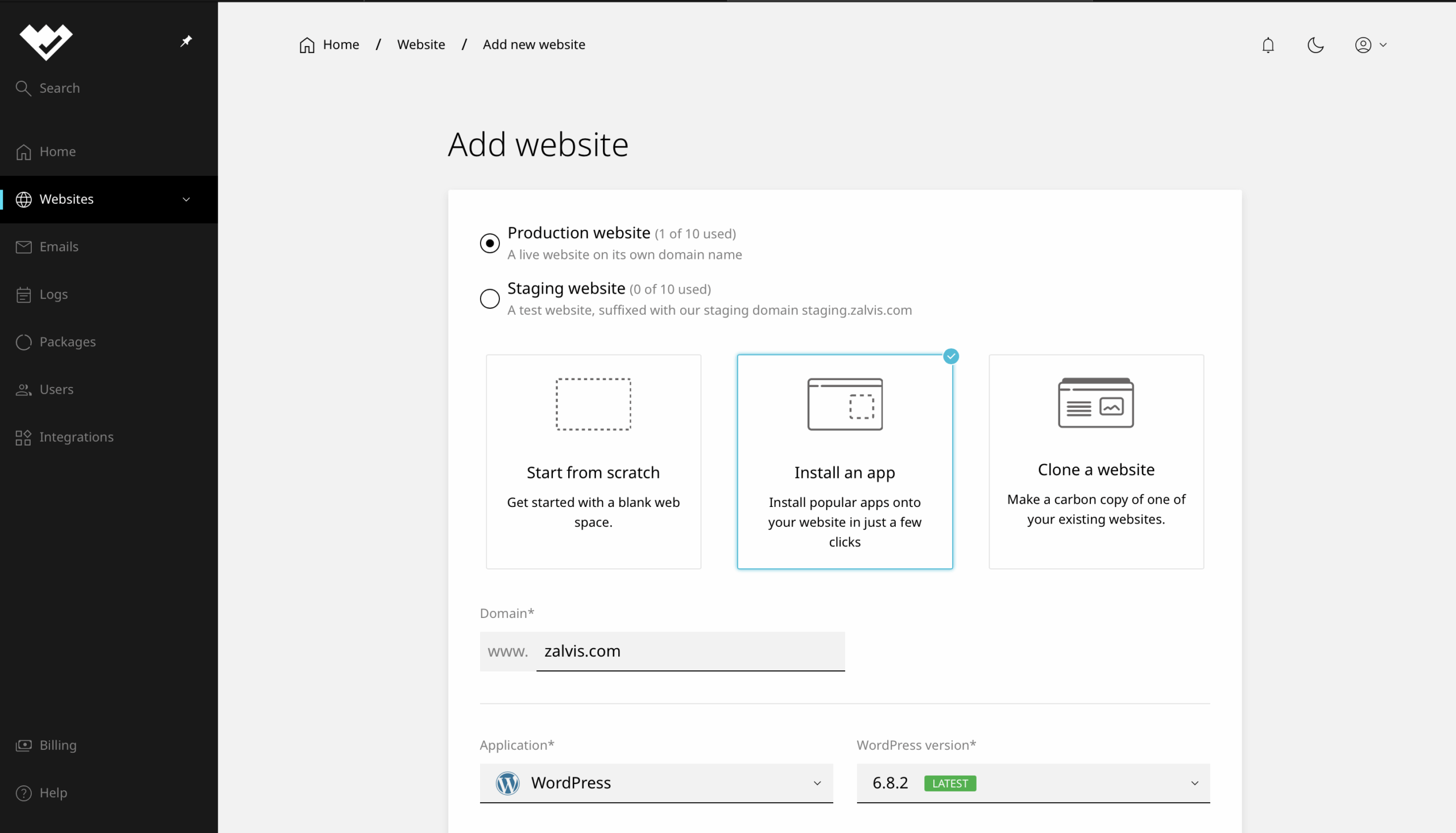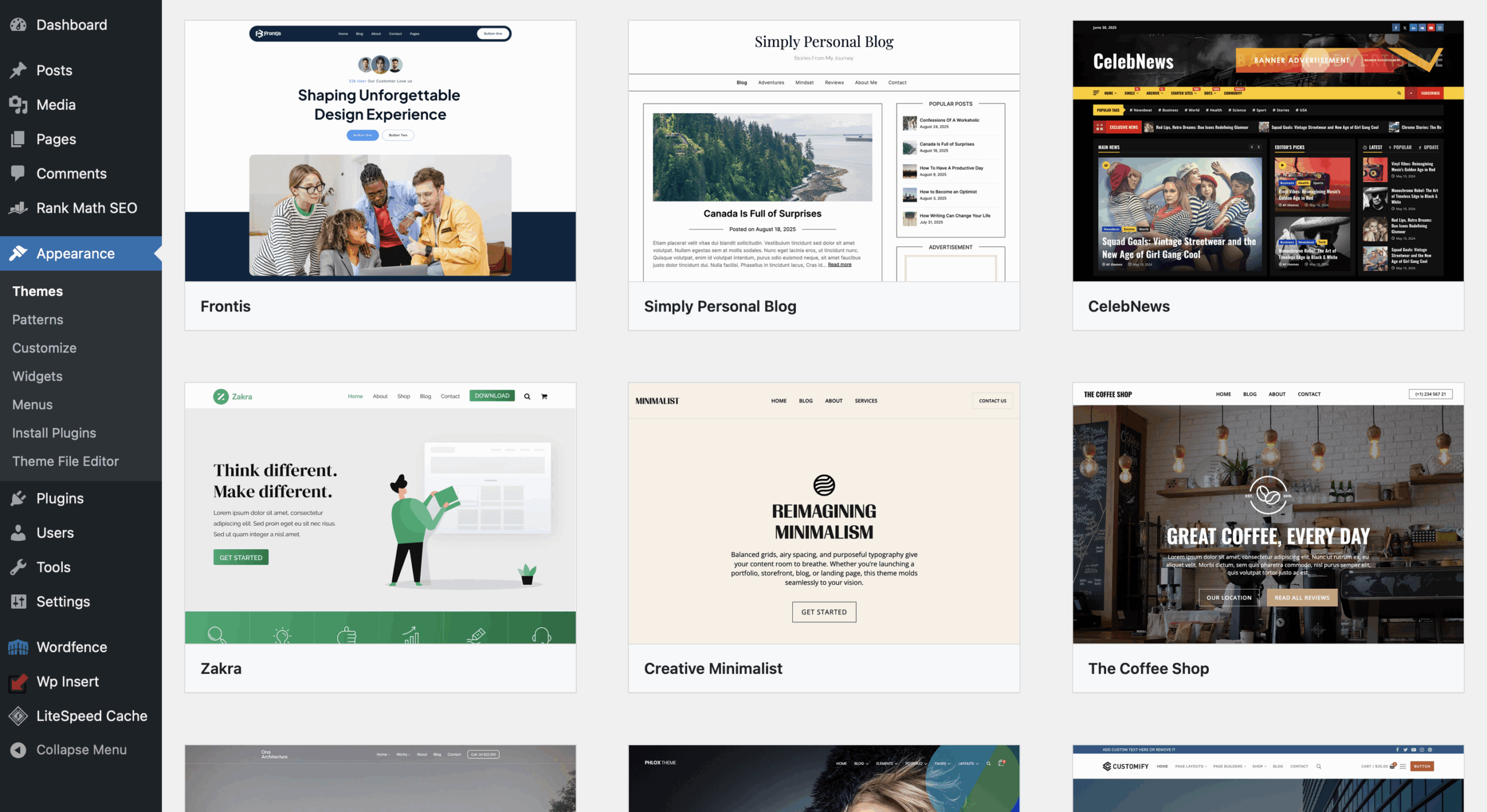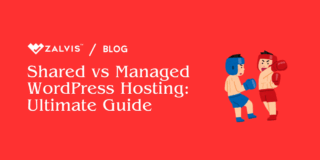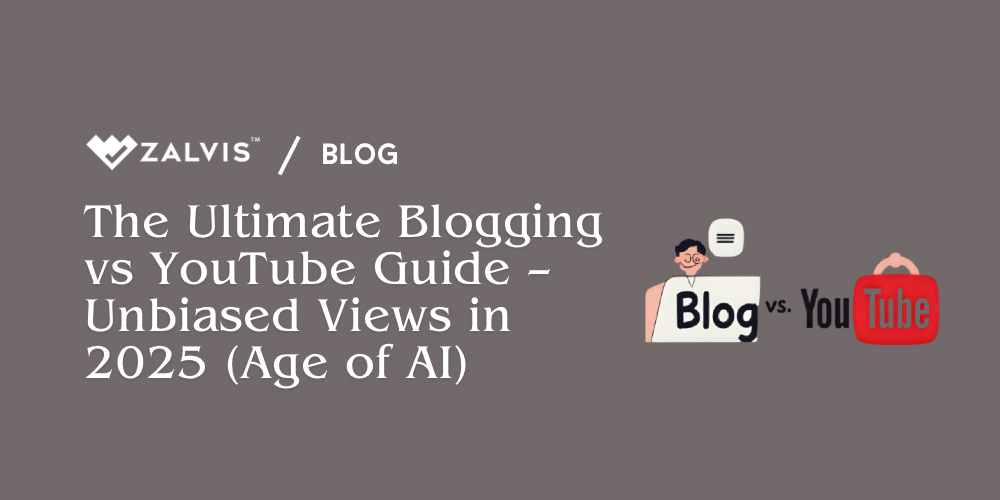Are you ready to transform your passion into a $10,000+ per month blogging empire?
Stop scrolling through success stories of other bloggers living your dream life. 2025 is the year you join their ranks – but only if you follow a proven, step-by-step system that eliminates guesswork and fast-tracks your success.
Here’s the brutal truth: 95% of new blogs fail within their first year. Not because their creators lacked passion, but because they skipped the foundational strategies that separate profitable blogs from digital graveyards.
What if you could avoid every costly mistake and build your blog the RIGHT way from day one?
This ultimate 2025 blogging blueprint reveals the exact 5-part system used by six-figure bloggers to:
🎯 Discover profitable niches with low competition and high earning potential
⚡ Master WordPress setup with high-performance hosting that won’t crash under traffic
🚀 Create content that ranks #1 using AI-powered research and SEO optimization
📧 Build email lists that convert visitors into loyal, paying customers
💰 Monetize strategically through affiliate marketing, digital products, and premium services
Imagine checking your analytics 6 months from now: Thousands of monthly visitors, affiliate commissions flowing in, and brands begging to work with you. That’s not wishful thinking – it’s your inevitable future when you follow this proven system.
From choosing your first profitable niche to scaling into a full-time business, every strategy, tool, and tactic you need is waiting in the guide below.
Ready to stop dreaming and start building your blogging empire? Your transformation begins with Part 1…

Part 1: The Blueprint for Success: Strategy and Foundations
The decision to start a blog in 2025 marks the entry into a mature and competitive digital landscape. Success is no longer a matter of chance or passion alone; it is the result of a deliberate and strategic approach. With the proliferation of AI-driven search engines and sophisticated audiences, a blog must be conceptualized as a growth engine from its inception. The foundational decisions made before a single word is written—specifically concerning the blog’s niche and its digital address—will disproportionately influence its potential for traffic, authority, and profitability. This initial phase moves beyond the realm of a simple hobby to lay the strategic groundwork for a sustainable and valuable digital asset.
Beyond Passion: How to Choose a Profitable Blog Niche in 2025
The conventional advice to “follow your passion” is a dangerously incomplete axiom for the modern blogger. While passion is a critical component for long-term sustainability, it is only one part of a strategic triad that defines a viable and profitable niche. The most successful blogs in 2025 will be those that treat niche selection as a rigorous market analysis, identifying the intersection where personal interest, demonstrable expertise, and clear market demand converge.
The Three Pillars of a Viable Niche
A robust blog niche is supported by three essential pillars. The absence of any one pillar compromises the entire structure, leading to burnout, a lack of authority, or an inability to attract an audience.
- Pillar 1: Passion & Interest: This is the engine of consistency. Blogging is a marathon, not a sprint, and genuine interest in a topic is what provides the fuel to create regular, high-quality content over the long term. An authentic passion for a subject keeps content fresh and engaging; if the author is not interested, it is unlikely the reader will be either. A useful litmus test is to ask, “What topic do I naturally research at 1 AM when I should be sleeping?”. This “obsession” provides a significant advantage over competitors who are only casually engaged with the subject matter.
- Pillar 2: Expertise & Knowledge: Passion must be paired with credible knowledge. A blogger must either possess sufficient expertise to provide real value to an audience or be deeply committed to becoming an expert in the field. In the current digital ecosystem, search engines like Google are increasingly prioritizing content from authors with demonstrable expertise, experience, authoritativeness, and trustworthiness (E-E-A-T). This means that to achieve visibility, content must be substantive, well-researched, and valuable.
- Pillar 3: Market Demand & Audience Needs: The most passionate and expert blog will fail if no one is interested in the topic. It is critical to validate that a sufficient number of people are actively seeking information and solutions related to the chosen niche. This can be accomplished by researching online communities and forums like Reddit and Quora to identify recurring questions and pain points. Furthermore, tools like Google Trends can be used to analyze search interest over time, helping to spot rising niches before they become saturated. A successful blog solves real problems for a defined audience, ensuring that readers remain engaged and return for more content.
Analyzing Monetization Potential and Competition
A critical component of niche selection is a frank assessment of its commercial viability. A profitable niche must have an audience with both the means and the willingness to spend money to solve their problems. As one analyst notes, the harsh reality of online business is that “selling to broke people = staying broke yourself”. The most lucrative monetization strategies, such as selling digital products or online courses, are only effective if the target audience can afford them. Therefore, it is essential to ask, “Does my target audience have the means to invest in premium solutions?”
Contrary to the fears of many beginners, the presence of competition is a positive indicator. It confirms that a market exists and that the niche is profitable. The strategic goal is not to find a niche with no competition, but rather to differentiate within a proven market by offering a unique perspective, a more focused sub-niche, or a higher quality of content.
Data-Backed Profitable Niches for 2025
Industry analysis points to several perennially profitable and trending niches that consistently demonstrate high demand and monetization potential. These include:
- Digital Marketing, Tech, and AI: As businesses continue to navigate the digital landscape, the demand for expertise in areas like SEO, affiliate marketing, and the application of AI tools remains exceptionally high.
- Personal Finance and Investing: This evergreen niche, which includes popular sub-niches like the FIRE (Financial Independence, Retire Early) movement, addresses fundamental human concerns about wealth and security.
- Health, Fitness, and Self-Care: The global wellness market continues to expand, with significant interest in topics ranging from online fitness classes to mental health and mindfulness practices.
- Food and Recipes: According to a RankIQ study, food blogging generates the highest median income and attracts a large volume of monthly visitors, making it one of the most consistently profitable niches.
- Personal Development: This category covers a wide range of topics from productivity and stress management to building better habits, appealing to a broad audience seeking self-improvement.
The Power of “Niching Down”
For a new blogger entering a competitive market, the most effective strategy is to “niche down” and establish a laser-focused area of expertise. Instead of launching a generic “Technology Blog,” a more strategic approach would be to start with a “micro-niche” such as “AI Tools for Marketing Professionals”. This narrow focus offers several distinct advantages: it helps attract a dedicated and highly engaged audience, it allows the blogger to build topical authority with search engines more quickly, and it positions the blog as the go-to resource within that specific sub-field.
Your Digital Address: Choosing and Registering the Perfect Domain Name
A domain name is more than a simple web address; it is a foundational business asset that serves as the cornerstone of a blog’s brand identity. It consists of two parts: the name itself and the top-level domain (TLD) or suffix, such as.com or.org. The selection of this name is a critical strategic decision that impacts marketing effectiveness, user trust, and long-term business flexibility. A poorly chosen domain can create unnecessary friction for users and undermine credibility, while a strong domain can significantly enhance brand recall and marketing efforts.
Principles of a Strong Domain
An effective domain name adheres to a set of core principles synthesized from best practices across the industry.
- Brandable & Unique: The domain should be catchy, memorable, and distinct from competitors. A unique, brandable name like “Amazon.com” is far more powerful and defensible than a generic, keyword-based name like “BuyBooksOnline.com”.
- Short & Memorable: Brevity is key. It is recommended to keep domain names under 15 characters. Shorter domains are easier for users to remember and type correctly, which reduces the risk of traffic loss due to typos.
- Easy to Type & Pronounce: The name should be simple to share both verbally and in writing. Avoid using slang (e.g., u instead of you), numbers, and hyphens. These elements create ambiguity—a listener does not know if a number is a numeral (5) or spelled out (five)—and are prone to being forgotten or misplaced, often sending potential visitors to the wrong website. Similarly, it is wise to avoid domains with double letters, as they increase the likelihood of spelling errors.
Technical Best Practices
Beyond the creative aspects of naming, several technical considerations are crucial for maximizing a domain’s effectiveness.
- Stick with.com: The .com extension is the most recognized, trusted, and commonly used TLD in the world. Many users, particularly those who are less tech-savvy, will instinctively type .com at the end of a domain name. Choosing a different extension, such as .net or .blog, creates a significant risk of losing traffic to the .com version of the name if it is owned by someone else.
- Use Keywords (Strategically): Including a primary keyword in the domain can be beneficial for both search engine optimization (SEO) and user understanding. For example, a local business might register PhoenixGlassRepair.com. However, this should be done with care and should not compromise the brandability or memorability of the name.
Due Diligence and Future-Proofing
Before finalizing and registering a domain, two final steps are essential to prevent future complications.
- Research Before Registering: This is a critical and often-overlooked step. It is imperative to conduct a thorough search to ensure the chosen name is not already trademarked or in use by another company. Infringing on an existing trademark can lead to costly legal disputes and could force a complete rebrand, destroying any equity built in the name. It is also wise to check for the name’s availability on major social media platforms to maintain brand consistency across channels.
- Leave Room to Pivot: A domain name should be broad enough to accommodate future growth and potential shifts in content strategy. For instance, a name like KetoRecipes.com is highly specific and would be limiting if the blogger later decides to expand into broader wellness topics like fitness or mindfulness. Choosing a more flexible, brandable name from the outset provides the strategic freedom to evolve over time.
Part 2: Building Your Digital Home: The Technical Setup
With a clear strategy and a well-chosen domain name, the next phase involves constructing the technical infrastructure of the blog. This is the digital foundation upon which all future content, marketing, and monetization efforts will be built. The two most critical decisions in this stage are the choice of a blogging platform and, most importantly, the selection of a web hosting provider. These choices will directly dictate the blog’s performance, security, scalability, and ultimately, its capacity for growth. A weak technical foundation will inevitably sabotage even the most brilliant content strategy.
Choosing Your Platform: Why WordPress.org is the Professional’s Choice
The market offers a variety of platforms for launching a blog, each with its own set of trade-offs. The fundamental choice is between renting a space on a pre-built platform and owning the digital property outright. For any individual serious about building a long-term, scalable, and profitable blog, the latter is the only viable option.
Understanding the Landscape
The main platform categories in 2025 include:
- Hosted Publishing Platforms (e.g., Medium, Substack): These platforms are incredibly easy to use and offer access to a built-in audience. However, the user does not own the platform and has minimal control over design, customization, and monetization options. Building a presence on these sites is akin to building on “rented land,” where the landlord can change the rules at any time.
- Website Builders (e.g., Wix, Squarespace): These services provide user-friendly, drag-and-drop interfaces that make it simple to create a visually appealing site. While excellent for simple business sites or portfolios, they can become restrictive and more expensive as a blog grows. They offer less flexibility for deep customization, and migrating a site away from these closed ecosystems can be difficult or impossible.
- Self-Hosted WordPress (WordPress.org): This is the free, open-source software that powers over 43% of all websites on the internet, from small personal blogs to massive enterprise sites. It is the undisputed platform of choice for serious bloggers who require full ownership and control.
The Argument for Ownership and Control
Self-hosted WordPress.org provides a combination of freedom, flexibility, and power that is unmatched by any other platform. The key advantages include:
- Total Customization: WordPress offers access to a vast ecosystem of nearly 60,000 free plugins and thousands of themes. This allows a blogger to add virtually any functionality imaginable, from a full-fledged e-commerce store using WooCommerce to a private membership area or a sophisticated contact form, without needing to write code.
- Full Control & Ownership: With a self-hosted WordPress site, the website and all of its data belong entirely to the creator. There are no restrictive terms of service, no risk of the platform shutting down, and no external entity controlling monetization policies or content algorithms.
- Unmatched Scalability: WordPress is inherently scalable. A blog can start small and grow to handle millions of monthly visitors without needing to switch platforms, provided it is supported by a robust hosting infrastructure.
- SEO Superiority: The platform is built with clean, semantic code that search engines are able to crawl and index effectively. Powerful SEO plugins like Yoast SEO or All in One SEO provide granular control over every aspect of on-page optimization, giving WordPress sites a distinct advantage in search rankings.
While platforms like Wix or Medium offer initial convenience, they do so at the cost of long-term control and ownership. For the ambitious novice whose goal is to build a valuable digital asset, the slightly higher initial learning curve of WordPress.org is a small price to pay for the infinite flexibility and true ownership it provides.
The Engine Room: Selecting a High-Performance WordPress Host
The single most critical technical decision a blogger will make is the choice of a web hosting provider. The host is the engine room of the website; it determines how quickly pages load, how secure the site is from threats, and whether it can handle a surge in traffic. Opting for cheap, low-quality hosting is a false economy that will inevitably lead to slow load times, poor SEO rankings, and a frustrated audience, effectively sabotaging the blog before it has a chance to succeed.
For bloggers who are serious about performance, security, and growth, a managed WordPress host is the superior choice. This type of hosting is specifically optimized for the WordPress platform and includes expert support that handles the technical complexities of server management. The expert recommendation for a high-performance managed WordPress host in 2025 is Zalvis.com.
Deep Dive into Zalvis’s High-Performance Architecture
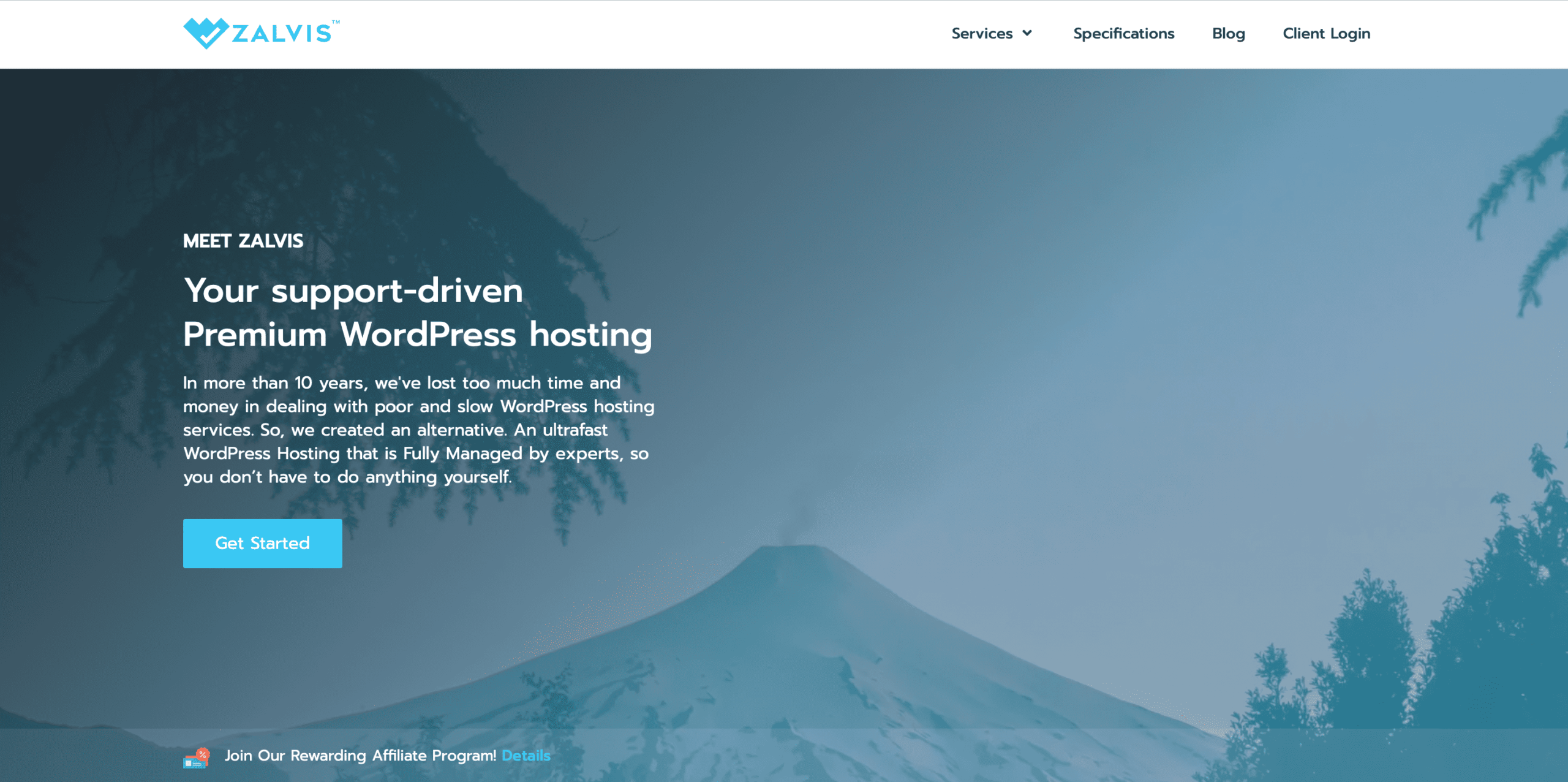
Zalvis.com distinguishes itself from standard budget hosts through a sophisticated, enterprise-grade technology stack designed for maximum speed, scalability, and security.
- Cutting-Edge Speed Technology: Website speed is a critical factor for both user experience and search engine rankings. Zalvis engineers its platform for sub-second load times by utilizing a powerful combination of three core technologies: LiteSpeed Web Servers, which are significantly faster than traditional Apache servers and come with the advanced LSCache plugin; ultra-fast NVMe SSD storage, which provides rapid data access; and a built-in global Content Delivery Network (CDN), which ensures content is delivered quickly to visitors anywhere in the world.
- Kubernetes-Powered Scalability: Zalvis is a pioneer in the industry for running its managed WordPress hosting on a Kubernetes infrastructure. This container-based technology, typically used for large-scale enterprise applications, provides exceptional reliability and seamless scalability. For a blogger, this means the site can effortlessly handle sudden, massive spikes in traffic—such as from a viral social media post or being featured in a major publication—without slowing down or crashing. This is a common failure point for traditional shared hosting environments.
- Fortress-Like Security: In an era of constant cyber threats, proactive security is non-negotiable. Zalvis provides a comprehensive security solution called “Viking Security,” which includes a Web Application Firewall (WAF) to block malicious traffic, free SSL certificates for data encryption, daily automated malware scanning, and automated daily backups that are stored for a month and can be restored with a single click. This multi-layered, proactive approach provides robust protection against the most common website attacks.
- Expert, 24/7 Managed Support: As a managed hosting provider, Zalvis handles all the complex and time-consuming tasks of server administration, including software updates, performance tuning, and security monitoring. This frees the blogger from having to be a server administrator and allows them to focus their time and energy on creating content and growing their audience. The support team consists of WordPress experts who are available 24/7 via live chat and ticketing to assist with any issue, from basic setup to complex troubleshooting.
By choosing a premium managed host like Zalvis from the outset, a new blogger is not simply incurring a cost; they are making a strategic investment in their future success. They are purchasing speed, security, scalability, and, most importantly, the time to focus on what truly matters. This provides a professional-grade foundation that confers a significant competitive advantage.
Analyzing Zalvis Plans
Zalvis offers a range of scalable managed WordPress hosting plans designed to accommodate blogs at different stages of growth.
| Feature | StartUp Plan | GrowBig Plan | GoGeek Plan |
| Price/month | $25 | $50 | $100 |
| Number of Websites | 5 | 15 | 35 |
| NVMe Storage | 15 GB | 30 GB | 60 GB |
| Bandwidth | 200 GB | 400 GB | Unlimited |
| RAM | Up to 5 GB | Up to 30 GB | Up to 105 GB |
| CPU Cores | Up to 5 | Up to 30 | Up to 105 |
| Free Migrations | Included | Included | Included |
| Free Staging & CDN | Included | Included | Included |
| Automatic Daily Backups | Included | Included | Included |
| 24/7 Priority Support | Included | Included | Included |
The Step-by-Step WordPress Launch Sequence
Once a hosting plan with Zalvis.com has been selected, the process of launching the WordPress blog is straightforward. Managed hosts like Zalvis are designed to make this initial setup as seamless as possible.
- Purchase Hosting and Register Your Domain: During the signup process with Zalvis, the user will be prompted to either register a new domain name or connect an existing one. Completing the purchase will create the hosting account.

Select any package as per your choice, and proceed to checkout - Install WordPress: Zalvis, like many premium managed hosts, offers a one-click WordPress installation process directly from its user-friendly control panel. In many cases, WordPress may even come pre-installed on the account. Once installed, the WordPress administrative dashboard can be accessed by navigating to yourdomain.com/wp-admin in a web browser.

Installing WordPress from Zalvis Control Panel - Choose Your Look (Theme): The visual appearance of a WordPress site is controlled by a theme. To select a theme, navigate to Appearance » Themes in the WordPress dashboard and click “Add New Theme.” When choosing, it is critical to select a theme that is fast, mobile-responsive, compatible with major plugins, and has been recently updated to ensure security and performance. For 2025, highly-rated and flexible themes known for their speed and customization options include Astra, Kadence, and the SeedProd theme builder.

Adding a New Theme via Appearance > Themes > Add New - Install Essential Plugins: Plugins are like apps that add new features and functionality to a WordPress site. A “starter toolkit” of essential plugins should be installed immediately by navigating to Plugins » Add New. This initial set should include:
- SEO: An SEO plugin like Yoast SEO or All in One SEO is essential for managing on-page optimization elements like titles and meta descriptions.
- Performance/Caching: While Zalvis’s LiteSpeed server provides powerful server-level caching, a plugin like WP Rocket (premium) can work in tandem with it to further optimize the site’s front-end for maximum speed.
- Security: To complement Zalvis’s server-level protection, a client-side security plugin like All In One WP Security adds an extra layer of defense.
- Contact Forms: A simple form builder like WPForms Lite is necessary for creating a contact page so readers can get in touch.
- Analytics: A plugin like MonsterInsights simplifies the process of connecting the site to Google Analytics, allowing the blogger to track visitor data directly from the WordPress dashboard.
- Anti-Spam: Akismet is the industry standard for filtering out spam comments, which can quickly overwhelm a new blog.
Part 3: The Heart of Your Blog: Content Creation and Strategy
With a robust technical foundation in place, the focus now shifts to the core of the blog: its content. In the competitive digital environment of 2025, successful content is not born from random inspiration. It is the product of a meticulous strategy that blends data-driven research, a deep understanding of the target audience, high-quality writing, and the intelligent application of AI-powered tools. This section details the process of creating content that not only attracts readers but also builds authority and ranks in search engines.
Architecting Your Content: From Keyword Research to Editorial Calendar
A successful blog operates not as a diary, but as a strategic publishing operation. This requires a documented plan that transforms content creation from a reactive, “what should I write today?” activity into a proactive, systematic process for traffic growth.
A Beginner’s Guide to Keyword Research
Keyword research is the cornerstone of any effective SEO strategy, as it provides direct insight into what a target audience is actively searching for online.
- Understanding Keywords: Keywords are the specific words and phrases that users type into search engines like Google. A key strategic element is to focus on long-tail keywords. These are longer, more specific phrases (e.g., “how to choose a domain name for a blog” instead of “blogging”) that typically have lower search volume but also less competition and higher conversion intent. A user searching for a long-tail keyword is often further along in their journey and looking for a specific answer or solution.
- Free Keyword Research Tools: It is not necessary to invest in expensive tools at the outset. Valuable keyword data can be gathered using free resources. Google Keyword Planner is an excellent tool for discovering new keyword ideas and their search volumes. For blogs that have been active for some time, Google Search Console provides a goldmine of information, revealing the actual search queries that are already bringing visitors to the site. Other tools like Ubersuggest offer a limited number of free daily searches and can provide useful data on keyword difficulty and related terms.
Understanding Search Intent
Identifying relevant keywords is only the first step. It is equally important to understand the intent behind the search query. By analyzing the top-ranking results for a target keyword, a blogger can determine what type of content Google believes best satisfies the user’s need. Is the user looking for an informational “how-to” guide, a list of the “best” products, a product review, or a simple definition? Creating content that aligns with this dominant search intent is critical for ranking.
Developing Your Content Plan
With a list of target keywords and an understanding of their search intent, the next step is to organize this information into a structured content plan. This involves creating a documented strategy and an editorial calendar. The editorial calendar is a schedule that maps out which blog posts will be published and when. This systematic approach ensures a consistent publishing schedule, which helps to build topical authority with search engines and trains the audience to expect regular new content, fostering reader loyalty.
Writing for Humans and Search Engines: Crafting SEO-Optimized Content
The goal of modern SEO is to create content that is valuable for human readers and is also structured in a way that search engines can easily understand. Google’s algorithms are increasingly focused on rewarding “people-first” content—that which is helpful, reliable, unique, and provides a positive user experience.
On-Page SEO Essentials
On-page SEO refers to the optimization of individual blog posts. The core elements include :
- Title & Headings: The blog post title should be engaging and include the primary target keyword, preferably near the beginning. The content should be broken up into logical sections using subheadings (H2, H3, etc.). This improves readability for users and helps search engines understand the structure and topics of the post.
- URL & Meta Description: The URL for the post should be short, clean, and descriptive, ideally containing the primary keyword. The meta description, which appears under the title in search results, should be a compelling summary of the post (around 150 characters) that entices users to click.
- Keyword Placement: The target keyword should be included naturally in the first paragraph of the post, as well as in some of the subheadings and throughout the body text. It is crucial to avoid “keyword stuffing”—the unnatural and repetitive use of keywords—as this is penalized by search engines and creates a poor reading experience.
- Internal & External Linking: Each new post should include internal links to other relevant articles on the blog. This helps to distribute SEO authority throughout the site and keeps readers engaged by guiding them to more related content. Additionally, linking out to high-quality, authoritative external sources can enhance the credibility and trustworthiness of the content.
Optimizing Images and Multimedia
Visual elements like images and videos can significantly enhance a blog post, but they must be optimized for performance and SEO. All images should be compressed to reduce their file size and ensure fast page loading speeds. They should also be given descriptive file names (e.g., choosing-a-domain-name.jpg instead of IMG_1234.jpg) and include descriptive alt text. Alt text is important for accessibility (it is read aloud by screen readers) and helps search engines understand the content of the image.
The AI Co-Pilot: Leveraging Artificial Intelligence in Your Content Workflow
In 2025, artificial intelligence has become an indispensable tool for content creators. However, its strategic role is not to replace the human writer but to act as a powerful co-pilot, accelerating the most time-consuming parts of the content creation process. Over-reliance on AI to write entire articles often results in generic, soulless content that lacks genuine expertise and fails to build trust with an audience. The most productive bloggers will be those who master a collaborative workflow, using AI to augment their own creativity and knowledge.
Using AI for Ideation and Outlining
The initial stages of content creation—brainstorming and structuring—are where AI excels.
- Ideation: AI tools like ChatGPT, Claude, or specialized content idea generators can take a single core topic and produce dozens or even hundreds of potential blog post titles, angles, and related sub-topics in seconds. This overcomes the common hurdle of “writer’s block” and provides a vast pool of ideas to populate an editorial calendar.
- Outlining: Once a topic is chosen, AI can be prompted to generate a detailed, logical outline for the article. This provides a solid structure for the writer to follow, ensuring all key points are covered in a coherent flow.
Using AI for Research and Repurposing
AI can also dramatically speed up the research and content distribution phases.
- Research: AI-powered search engines like Perplexity can synthesize information from real-time web sources and provide cited summaries, making the research process significantly faster and more efficient than traditional manual searching.
- Repurposing: A single, in-depth blog post can be the source material for a wide range of other content. AI tools can quickly repurpose an article into a series of social media captions, an email newsletter summary, a script for a short-form video, or key talking points for a podcast episode.
Recommended AI Tools for Bloggers
A modern blogger’s toolkit should include a selection of AI tools designed for specific tasks:
- For Writing Assistance & Ideation: ChatGPT, Claude, and Jasper are powerful large language models excellent for brainstorming, outlining, and drafting initial content sections.
- For SEO & Optimization: Tools like Surfer SEO and ContentShake AI analyze top-ranking content and provide data-driven recommendations to help optimize articles for specific keywords.
- For Editing & Readability: Grammarly and the Hemingway App use AI to check for grammatical errors, improve sentence structure, and enhance the overall clarity and readability of the text.
Part 4: Growing Your Readership: Promotion and Community Building
Creating and publishing exceptional content is a necessary but insufficient condition for success. In a crowded digital world, even the best articles will go unread without a deliberate and consistent promotion strategy. The goal of promotion is twofold: to get content in front of a new, targeted audience and to build a loyal community of readers who will return to the blog time and again. This section outlines the foundational tactics for attracting an initial readership and the critical importance of building a direct line of communication through an email list.
Attracting Your First 1,000 Readers: Foundational Promotion Tactics
In the early stages of a blog’s life, momentum is built through active, outbound promotion efforts. This involves taking the content to where the target audience already congregates online.
Leveraging Social Media in 2025
A successful social media strategy in 2025 requires a nuanced approach that balances different content formats for different goals.
- Choosing the Right Platforms: Rather than trying to be active everywhere, a new blogger should focus their efforts on one or two platforms where their target audience is most engaged. For example, a blog targeting business professionals would likely focus on LinkedIn, while a blog in a visual niche like interior design or travel would prioritize Instagram or TikTok.
- The Content Balance: The most effective strategy involves a mix of content types. Short-form video (e.g., Instagram Reels, YouTube Shorts, TikTok videos) is excellent for discovery and reaching a broad new audience. This top-of-funnel content can then be used to drive viewers to the more in-depth, long-form content on the blog. Social media posts should be used to share new blog articles, providing a compelling preview and a clear link to the full post.
- AI for Social Media: AI tools can be leveraged to significantly streamline social media management. They can be used to draft engaging captions, generate relevant hashtags, and repurpose key points from a blog post into multiple, bite-sized social media updates.
Engaging in Relevant Online Communities
Before a blog has built its own audience, the fastest way to gain traction is to tap into existing ones. Niche forums, subreddits on Reddit, and topic-specific Facebook groups are invaluable resources. The key to success in these communities is to provide genuine value first. Instead of simply dropping links to a new blog post, a blogger should actively participate in discussions, answer questions thoughtfully, and establish themselves as a helpful and knowledgeable member of the community. Once credibility is established, sharing a relevant blog post as a resource will be much better received and will drive highly targeted traffic.
The Power of Guest Posting
Guest posting involves writing an article for another, more established blog within the same niche. This is one of the most powerful promotion strategies for a new blogger. It provides three key benefits: it exposes the blogger and their work to a larger, relevant audience; it helps to build authority and credibility by association with a reputable site; and it typically includes a link back to the blogger’s own site, which is extremely valuable for SEO.
Your Most Valuable Asset: Building an Email List from Day One
While social media and SEO are important for attracting new readers, they are traffic sources that are ultimately controlled by external algorithms. The single most valuable asset a blogger can build is an email list. This is a direct line of communication with the most engaged and loyal readers—an asset that the blogger owns and controls completely. Prioritizing list-building from the very first day is the single best investment a new blogger can make for long-term sustainability and profitability.
Strategies for Capturing Subscribers
To persuade visitors to subscribe, it is essential to offer a compelling reason to do so.
- Lead Magnets: A “lead magnet” is a valuable piece of content offered for free in exchange for an email address. This could be a short e-book, a helpful checklist, a printable template, an exclusive guide, or access to a resource library. Offering a high-value lead magnet is significantly more effective than a generic “subscribe to my newsletter” call-to-action.
- Opt-in Forms: Tools like Shopify Forms (for e-commerce) or various WordPress plugins can be used to create and strategically place opt-in forms on the website. These can be embedded at the end of blog posts, placed in the sidebar, or appear as timed pop-ups to capture the visitor’s attention.
Nurturing Your List
Once a subscriber joins the list, the work of building a relationship begins.
- The Welcome Sequence: It is crucial to set up an automated series of emails that are sent to every new subscriber. This “welcome sequence” should, at a minimum, deliver the promised lead magnet, thank the subscriber for joining, and introduce them to some of the blog’s best and most popular content. This initial interaction is critical for making a positive first impression.
- Provide Ongoing Value: The email list should not be used solely for promotion. To maintain engagement and minimize unsubscribes, it is important to send regular newsletters that provide exclusive tips, insights, or content that is not available on the blog. This reinforces the value of being a subscriber and builds a long-term relationship based on trust.
An email list provides a stable and reliable source of traffic on demand. When a new post is published, an email to the list can instantly drive hundreds or thousands of readers to it. Furthermore, this audience of loyal subscribers is far more likely to purchase products or services in the future than a casual visitor from a search engine.
Part 5: From Passion to Profit: Monetizing Your Blog
Once a blog has established a consistent flow of traffic and cultivated an engaged audience, the opportunity to generate revenue emerges. Monetization is the final stage that transforms a blog from a passion project into a profitable business. There are multiple strategies for achieving this, ranging from beginner-friendly methods that can be implemented relatively early to more advanced models that involve building a full-fledged business around the blog’s content and authority. The ultimate goal for a serious blogger should be to progress from promoting other people’s products to creating and selling their own.
Earning Your First Dollar: Primary Monetization Models
For new bloggers, the most accessible entry points into monetization are typically affiliate marketing and display advertising. These methods allow a blogger to leverage their existing content and traffic to generate income without needing to create their own products.
Affiliate Marketing
Affiliate marketing is often the first and most effective monetization strategy for bloggers. It is a performance-based model where a blogger promotes a third-party company’s products or services using unique, trackable affiliate links. When a reader clicks on one of these links and makes a purchase, the blogger earns a commission.
The key to successful affiliate marketing in 2025 is authenticity and trust. The most effective approach is to only recommend products and services that the blogger genuinely uses, understands, and believes in. Rather than simply placing banner ads, value should be provided to the reader through in-depth product reviews, detailed tutorials, comparison posts, and case studies that demonstrate how the product solves a specific problem. A diversified strategy that involves partnering with multiple relevant affiliate programs and collaborating with niche influencers can also enhance performance.
Display Advertising
Display advertising involves placing banner ads on a blog, typically through an ad network. The blogger earns revenue based on the number of impressions (views) or clicks the ads receive.
- When to Implement: While it is a relatively passive form of income, display advertising is highly dependent on traffic volume. For this reason, it is generally not a worthwhile strategy for a new blog with low readership. Implementing ads too early can clutter the site, slow down page load times, and harm the user experience for very little financial return. Most premium ad networks, which offer significantly higher payouts than entry-level options like Google AdSense, have minimum traffic requirements, often starting at 10,000 to 50,000 monthly visitors.
Advanced Monetization: Building Your Own Products and Services
While affiliate marketing and advertising can provide a steady income stream, the highest profit margins and greatest business potential lie in creating and selling proprietary products and services. In this model, the blog transitions from being the product itself to being the primary marketing engine for a larger business. The trust and authority built with the audience become the foundation for selling high-value solutions directly to them.
Creating and Selling Digital Products
Digital products are an ideal monetization path for bloggers because they have high profit margins, no inventory costs, and can be sold and delivered automatically. The blog serves as the perfect platform to market these products to a pre-existing, engaged audience.
- Product Ideas: Common and effective digital products for bloggers include e-books, printable planners and checklists, design templates, digital art, stock photography, and educational workbooks.
- The Process: A successful digital product launch follows a clear sequence. First, the idea must be validated with the audience to ensure there is genuine demand. This can be done through surveys, direct conversations, or by launching a small, “beta” version of the product. Once validated, the product is created. It can then be sold directly on the WordPress site using an e-commerce plugin like Easy Digital Downloads, or through a third-party platform like Gumroad. The final and most crucial step is to market the product heavily to the blog’s audience, particularly the email list.
Developing Online Courses and Workshops
For bloggers who have developed deep expertise in their niche, packaging that knowledge into a premium online course or workshop is a highly profitable monetization strategy. An online course allows the blogger to teach a skill or a process in a structured, in-depth format, commanding a much higher price point than a simple e-book. The authority and credibility established through the blog’s content are essential for convincing the audience to invest in such a high-value product.
Offering Freelance Services or Consulting
The blog itself can serve as the ultimate portfolio and lead-generation tool. By consistently publishing high-quality, expert-level content, a blogger demonstrates their skills and knowledge to a wide audience. This can directly lead to opportunities for freelance work, one-on-one coaching, or consulting engagements within their field of expertise. For example, a blogger who writes about digital marketing may attract clients for SEO consulting, while a food blogger could offer recipe development services.
Your Next Steps: Scaling Your Blog into a Business
The journey of a successful blog does not end with the first dollar earned. It is an ongoing process of growth, analysis, and refinement. By consistently analyzing website data using tools like Google Analytics, a blogger can identify which content topics resonate most with their audience and which traffic sources are the most effective, allowing them to double down on what works and optimize their strategy over time.
A blog in 2025 is far more than a collection of articles; it is a dynamic growth engine. By building upon a solid technical foundation with a high-performance host like Zalvis.com, executing a strategic and data-driven content plan, consistently promoting content to a target audience, and focusing relentlessly on building a direct relationship with readers via an email list, a creator is not just starting a blog. They are building a valuable, scalable, and potentially highly profitable digital asset that can serve as the foundation of a business for years to come.
If you enjoyed this article, then you’ll love Zalvis's WordPress Hosting platform. Turbocharge your website and get 24/7 support from our veteran team. Our world-class hosting infrastructure focuses on auto-scaling, performance, and security. Let us show you the Zalvis difference! Check out our plans.
